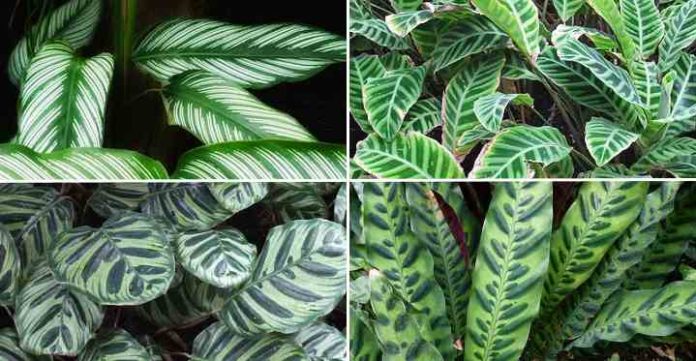Known for its splendid beauty and boldly marked oblong leaves, Calathea is a beautiful plant that people widely use for indoor office decoration. Various types of calathea plants decorate indoor spaces as they require less care and indirect lighting to grow.
Calathea is a part of a family of plants called Marantaceae, a popular species of plants known for its flowering plants.
With so many varieties of Calathea to choose from, it might be challenging to choose the right one for you.
Dont worry; we have done the hard work for you; we have come up with a list of incredibly beautiful types of Calathea so that you can choose the best one for you.
Read More- How To Grow String Of Dolphins Plant?
Types of Calathea
Irrespective of the variety, all types of calathea require a similar amount of care and attention for healthy and problem-free growth. If you plan to give your dull office a touch of beauty, try these types of calathea to transform your house or office.
Calathea Warscewiczii
Born in Costa Rica and Nicaragua, this tender herbaceous plant stays green all year round. Calathea warscewiczii is one of the most popular types of Calathea plants.
It has dark green leaves velvety in touch that form a fishtail-like pattern at the end. In the evening, these leaves close like any other nyctinastic plant.
On maturing, the plant grows upto 3 feet, with its leaves almost 12 inches long; all these features add to the beauty of this stunning variety of calathea plants.
When it comes to natural conditions, Calathea warscewiczii usually grows in moist, rich soil that is not specifically soggy and in areas with moist temperatures ranging between 60 Degree F to 80 Degree F. this plant needs relatively high humidity to grow, so if you opt for it, then you may have to place it on a humidity tray or use a humidifier to provide the right amount of humidity to it.
Although the plant does not require much care, it is advisable to keep it away from cold and drafty locations and provide bright indirect light. Providing too little light to it might result in leggy plants.
Calathea Makoyana
Calatheao makoyana is also known as cathedral windows or peacock plant because of the colorful and elaborate and colorful markings found on its egg-shaped foliage.
The thin papery leaves of this plant with purple undersides marked with light green color, with dark green peacock markings on them make it very eye catchy and attractive.
Each leaf of this incredibly beautiful is attached to a reddish-pink stem that adds to the color of this plant. To care for calathea makoyana, botanists suggest growing the kit in a fertile potting mix and keeping its soil evenly moist. High humidity and temperatures between 60 degrees F and 75 Degrees F are perfect for growing this plant.
Calathea Ornata Sanderiana
Calathea Ornata Sanderiana is a popular calathea breed from ornata. This breed is the perfect pick for you if you need to add a touch of tropical colors to your office or house with its broad leathery and glossy leaves.
The plant has dark spots on top with purple undersides, which are attached to the leaves,
The stems of this plant grow upto 2 feet; keep this plant healthy by taking good care of it as its mother, Calathea Ornata, would have done.
Calathea Roseopicta
Another popular and incredibly colorful type of Calathea is Calathea Roseopicta. This delightful plant, also known as ‘Rosey,’ remains evergreen,
The leaves of this plant are bordered with green and have cream and pink centers with a feather-like pattern.
To add to the magic of this rose plant, its leaves fold at nighttime, making it very appealing to the eyes.
On maturity, the plant grows upto 20 inches tall.
Calathea roseopicta is sure to add a boost of color to your house or office, making it look very extremely attractive.
Calathea zebrina
A tropical plant native to southeast brazil, Calathea Zebrina is also known as the Zebra Plant. The striking stripes on the velvety surface of the leaves of this plant perfectly describe why it is also known as the Zebra Plant.
Each leaf of this plant grows upto 12 hives long and folds at night like any other nyctinastic plant.
Although the plant does not usually bloom, it sometimes produces white flowers in the months of spring.
Calathea Zebrina is best grown in moist soil with high fertility, good drainage, and moderate temperatures of around 65 degrees F to 80 degrees F.
Keeping the plant in an area with bright filtered light for best growth results is suggested.
Calathea lancifolia
Calathea lancifolia, also known as the Rattlesnake Plant, because of the unique marking found on its foliage that resembles a reptile.
It is a relatively taller variety of Calathea, which grows up to 18 inches on maturing. The plant has long lacy and glossy leaves pale yellow on top and purple on the underside.
The leaves of this plant have dark green scars on both sides. This type of Calathea does not usually bloom; however, it produces yellow flowers with spikes of about 4 inches during springtime.
Keeping the rattlesnake plant healthy inst a challenging task; just make sure you keep the soil evenly moist and provide it with enough water.
Indoor temperatures of around 65 degrees F and 75 degrees F with bright filtered sunlight are the appropriate conditions to grow this type of calathea.
Make sure to treat it with half strengthened fertilizer at regular intervals to enjoy the beauty of a fuller. plant
Read More- What Are Some Good Creepers Plants Example?
How to take Care of Calathea Plant
Calathea isn’t one of those plants that require highly specialized care to have good growth.
It can grow well even with minimal care. If you are planning to grow a calathea plant, consider these simple tips to help you grow different types of calathea.
Soil
Moisture is the most important factor influencing the growth of various types of Calathea. So choosing soil with the right amount of moisture is very crucial. A potting mixture that is light in weight and airy would be perfect for growing calathea, as it would fulfill the needs of this plant well. Make sure to plant it in a pot with drainage holes to prevent it from drowning in excess water.
Botanists suggest using a slightly acidic soil with a pH of around 6.5 to grow various types of Calathea plants.
Light
While most tropical plants grow well in direct sunlight, the case with the calathea plant is a little different. Calathea plants are best grown in filtered, indirect light. In forests, they usually grow under the canopy of trees that protect them against the harsh rays of the sun. But when growing them domestically, it is very important to keep your calathea plants away from direct sunlight. Too much light tends to burn their leaves and cause their vibrant colors and patterns to fade away.
So it is advised to grow your calathea plants in places that receive filtered and light sunshine.
Water
Calathea is a thirsty plant and needs to be watered regularly to maintain the moisture in its soil. Depending on the climatic conditions of the area you are planning to plant this plant, the watering schedule of this plant may vary from place to place. The most important rule is to prevent the soil from drying out.
To check this, make sure that the leaves of your calathea plant arent browning or withering on the edges.
If you see any of these happening, it is a clear sign that you are probably not watering the plant properly.
You can water all the types of calathea plants with rainwater, tap water, or filtered water.
Read More- Most Common Pothos Varieties For Indoor Gardening
Fertilizer
Treat your calathea with a liquid fertilizer once a month for a luscious plant full of leaves.
This can be done in all the seasons except winters as it naturally grows less at that time.
Humidity and Temperature
Warm and pleasant temperatures are the best for growing various types of calathea. Choosing a spot that stays warm and pleasant most of the time during the day is very important.
Calathea thrives well in temperatures ranging from 7o degrees F to 85 Degrees F; they can also tolerate temperatures of about 60 degrees F but cannot survive in temperatures any lower than that.
It is suggested to keep your calathea away from cold, drafty environments and provide as much humidity as possible. This can be done by placing the plant in a humid place or by placing a humidifier nearby.
Terrariums are also a good option to provide the appropriate amount of humidity to the calathea plant.
Final Words:
Although all types of calathea are perfect for lightening up dull places, choosing one that caters to your needs has been made easy with this guide. The only thing you need to take care of when planting a Calathea plant is providing ample humidity and moisture.
You also need to make sure to keep your calathea away from a cold and drafty environment, or the plant may die.
Hope this article helped you choose the right type of Calathea for your home/office; if you have any other doubts, do let us know.
Happy planting!!
















